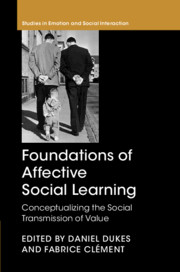Book contents
- Foundations of Affective Social Learning
- Studies in Emotion and Social Interaction
- Foundations of Affective Social Learning
- Copyright page
- Dedication
- Contents
- Figures
- Contributors
- Preface
- A difficult introduction to affective social learning
- Part I On the evolutionary foundations of affective social learning processes
- Part II On human development and affective social learning
- Part III On the mechanics of affective social learning
- Part IV Applications of affective social learning
- Chapter 8 Chastening the future
- Chapter 9 Insights from culture and emotion research for affective social learning
- Conclusion
- Index
- Studies in Emotion and Social Interation
- References
Chapter 9 - Insights from culture and emotion research for affective social learning
Emotional enculturation and acculturation
from Part IV - Applications of affective social learning
Published online by Cambridge University Press: 09 August 2019
- Foundations of Affective Social Learning
- Studies in Emotion and Social Interaction
- Foundations of Affective Social Learning
- Copyright page
- Dedication
- Contents
- Figures
- Contributors
- Preface
- A difficult introduction to affective social learning
- Part I On the evolutionary foundations of affective social learning processes
- Part II On human development and affective social learning
- Part III On the mechanics of affective social learning
- Part IV Applications of affective social learning
- Chapter 8 Chastening the future
- Chapter 9 Insights from culture and emotion research for affective social learning
- Conclusion
- Index
- Studies in Emotion and Social Interation
- References
Summary
In this chapter I revisit the literature on culture and emotion through the lens of affective social learning (ASL). Conceptualizing emotions as evaluations of the world, I consider the different processes through which people come to fit in emotionally with their culture as processes of ASL. By describing how children enculturate and immigrant minorities acculturate emotionally, I thus aim to shed more light on ASL. The main results of this undertaking are not only that culture and emotion are integral to the study of ASL, but also that ASL (i) encompasses many more processes than those initially described; (ii) affects children, immigrant minorities and even adult majorities; and (iii) is, in many cases, multidimensional and context-dependent. In closing the chapter, I outline some of the ways forward for studying ASL, such as further integrating it with other literatures and conducting empirical studies that take into account some of the complexities and contextual factors that may shape both its speed and course. By embarking on this journey, it is my hope (and belief) that ASL may become a mature and multidisciplinary approach that can stimulate novel research to shed light on meaning-making in context.
- Type
- Chapter
- Information
- Foundations of Affective Social LearningConceptualizing the Social Transmission of Value, pp. 205 - 233Publisher: Cambridge University PressPrint publication year: 2019
References
- 1
- Cited by

